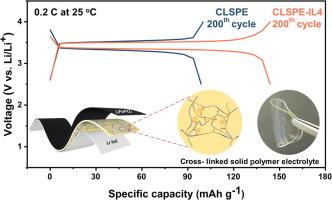The application of ionic liquids (IL) in polymer electrolytes represents a safer alternative to the currently used organic solvents in lithium batteries due to their nonflammability and thermal stability. However, as a plasticizer, it is generally agreed that the introduction of ionic liquid usually leads to a trade-off between ion transport and mechanical properties of polymer electrolyte. Here we report the synthesis of an IL-embedded polymer electrolyte with both high ionic conductivity (2.77 × 10−4 S cm−1 at room temperature) and excellent mechanical properties (high tensile strength up to 11.4 MPa and excellent stretchability of 387% elongation at break) achieved by strong ion–dipole interactions between polymer electrolyte components, which was unveiled by the DFT calculation. Moreover, this polymer electrolyte also exhibits nonflammability, good thermal stability and the ability to recover reversibly from applied stress, i.e., excellent elasticity. This highly viscoelastic polymer electrolyte enables tight interfacial contact and good adaptability with electrodes for stable lithium stripping/plating for 2000 h under a current density of 0.1 mA cm−2. By coupling with this polymer electrolyte, the LiFePO4/Li cells exhibit outstanding cycling stability at room temperature as well as the reliability under extreme environmental temperature or being abused.

| 公司名称 | 产品信息 | 采购帮参考价格 | |
|---|---|---|---|
| 百灵威 | Ethyl acrylate |
|
¥20.00~¥11634.00 |
| 百灵威 | ethylene glycol dimethacrylate |
|
¥20.00~¥9218.00 |

